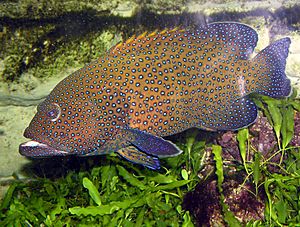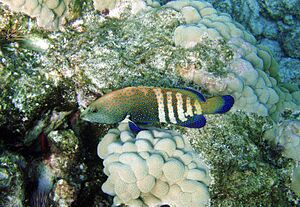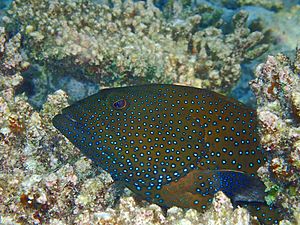Peacock hind facts for kids
Quick facts for kids Peacock hind |
|
|---|---|
 |
|
| Conservation status | |
| Scientific classification | |
| Synonyms | |
|
The peacock hind (Cephalopholis argus) is a colorful fish known by many names, like roi, bluespotted grouper, and celestial grouper. It's a type of grouper, which belongs to a larger fish family called Serranidae. This family also includes fish like anthias and sea basses.
Peacock hinds live in the warm waters of the Indo-Pacific region. People fish for them, keep them in aquariums, and sometimes they become an invasive species (meaning they spread to new places and cause problems). The fish's scientific name, argus, comes from an old Greek mythology monster named Argus. This monster had a hundred eyes, and the fish's many spots look a bit like those eyes!
Contents
What Does the Peacock Hind Look Like?

This fish is medium-sized. It can grow up to about 60 centimeters (2 feet) long. Young peacock hinds are dark brown. They have hundreds of small, bright blue spots with dark edges. These spots shimmer!
As the fish get bigger, they sometimes grow light-colored stripes. These stripes appear on the back half of their body.
Where Do Peacock Hinds Live?
Peacock hinds are found in many places around the world. They live in warm ocean waters. Their home range stretches from the Red Sea all the way to South Africa. You can also find them east to French Polynesia and the Pitcairn group of islands.
They are also present near northern Australia, Lord Howe Island, and Japan. These fish have even been brought to the Hawaiian Islands by people. Peacock hinds can live in different ocean environments. However, they prefer the outer edges of coral reefs. They like depths of up to 40 meters (130 feet).
How Do Peacock Hinds Live?
Hunting and Eating Habits
Peacock hinds are clever hunters. They often lie still on the ocean bottom. When they see prey, they quickly dart forward. They especially like to eat young surgeonfish and crustaceans (like crabs or shrimp). Sometimes, they just float still in the water before they attack.
These groupers can even work with other predators. They might follow an octopus or an eel. They can also hide themselves in a school of surgeonfish. Sometimes, several peacock hinds will team up. They might bother an eel to make it flush out prey for them. In the Red Sea, they usually hunt in the morning and evening.
Behavior and Social Life
Peacock hinds often sit on a coral head. If something scares them, they quickly hide.
In the Red Sea, male peacock hinds protect their territory. Each male has a group of 2 to 6 females. Their territory can be as big as half an acre. Each female also protects her own part of the territory from other females.
The male visits each female every day. He raises his dorsal fin to show he is coming. The female then comes out of her hiding spot. She also raises her dorsal fin and changes to a lighter color. They swim together, rubbing sides. Then the male leaves until the next day.
Sometimes, males have "color fights" over territory. Two males will face each other at right angles. They make their colors darker. Then they repeatedly change their stripes from dark to light. The male who loses turns pale and swims away. If the fight is a draw, the two males might attack each other.
Reproduction and Life Cycle
In Micronesia, peacock hinds usually lay their eggs at dusk. This happens within their territories. During courtship, both the male and female fish become darker. However, they get a white, keyhole-shaped patch in the middle of their bodies.
Peacock Hinds in Aquariums
The peacock hind is a strong fish for aquariums. But you need a very large marine aquarium to keep one. They grow big and can be aggressive. This means it's best to keep them alone. Or, you can keep them with other large, aggressive fish. Good tank mates might include lionfish or moray eels. Since they are predators, they will eat any smaller fish in the tank, like damselfish.
Peacock Hinds in Hawaii
In Hawaii, the peacock hind is called roi. This fish was brought to Hawaii in the 1950s. The idea was to help local fishing. However, Hawaii's Division of Aquatic Resources (DAR) found that roi have become the main predators on the reefs.
The number of roi in Hawaii has grown a lot. Since the 1980s, their population has increased 15 times. From 1999 to 2005, their numbers went up by 23%. Now, there are more roi by weight than all other reef fish predators combined.
Ciguatera Toxin
In other parts of the Pacific, people enjoy eating roi. But in Hawaii's waters, roi can carry a toxin called ciguatera. This toxin can make people very sick. It builds up in humans who eat the fish.
A study in 2007 found that 18% of roi from Oahu and Hawaii islands had unsafe levels of this toxin. It's hard to tell if a fish is toxic just by where it lives. The amount of toxin can be very different even between fish from the same area. Bigger roi might have slightly more toxin, but this is not a sure way to predict it. There is no easy test kit to check for the toxin. Because of this, people don't really fish for roi to sell in Hawaii. Sales are very low, averaging only about $1000 per year.
What Roi Eat in Hawaii
Scientists studied the stomach contents of roi in Hawaii. They found that 97.7% of their diet was fish. Only 2.3% was crustaceans.
The fish they eat most often are parrotfish (27.1%) and surgeonfish (18.7%). They also eat squirrelfishes, filefish, bigeyes, butterflyfish, and trumpetfishes. Roi are estimated to eat about 0.8% of their own body weight every day.
Impact on Hawaiian Reefs
Roi mainly eat young fish that are just starting to live on the reef. Parrotfish, which are a big part of the roi's diet, are very important for coral reefs. Parrotfish help keep the reefs healthy by eating algae that grows on corals. They also help create sand.
Hawaii has many unique fish species. About 24.3% of its nearshore marine fish are found nowhere else. Roi don't have many natural predators in Hawaii. This, along with how well they hunt, is a big threat to Hawaii's special fish. One expert, Dr. Jack Randall, said that roi have a greater impact in Hawaii than fishing and aquarium collecting combined. On the Kona coast, roi are thought to eat 11% of all reef fish by weight. They eat 72% of the total number of fish.
Roi Roundups
On the island of Maui, spearfishers take part in "Roi Roundup" tournaments. These events target roi to help reduce their numbers. The goal is to lessen their negative impact on the reefs. This idea has spread to other islands. There are now similar tournaments that target roi and other invasive fish. These events not only help control the roi population. They also help teach people about this important issue.
Conservation Status
The International Union for the Conservation of Nature (IUCN) says the peacock hind is of "Least Concern". This means it is not currently at risk of disappearing. It is common and found in many places. People catch them for food, for fun, and for the aquarium trade.
See also
 In Spanish: Cephalopholis argus para niños
In Spanish: Cephalopholis argus para niños



